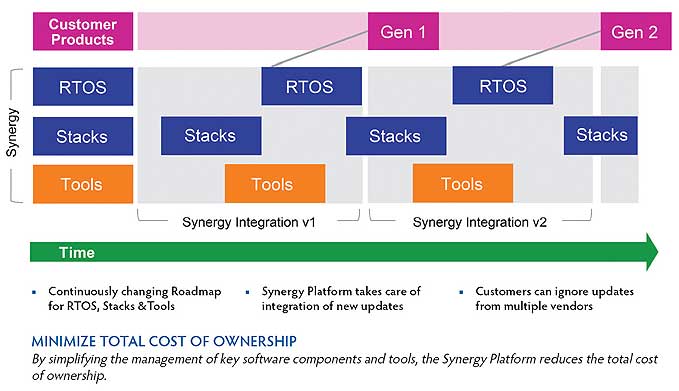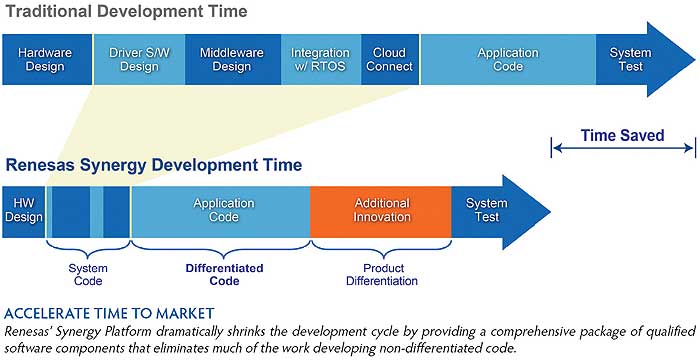Rapidly moving market requires integrated silicon/software platform.

Let’s face it – the opportunity the IoT market offers is unprecedented. The numbers alone are staggering. Analysts at Gartner Inc. estimate that 4.9 Billion connected devices will be in use by the end of 2015, up 30 percent from 2014. Five years from now they expect that number to jump to 25 Billion. By then those same analysts expect 10 billion connected
devices (excluding PCs, smartphones, and tablets) will ship each year into a market that researchers at IDC forecast to be worth over $7 Trillion.
At the heart of this exciting new market lies the 32-bit microcontroller (MCU), the source of the intelligence built into the majority of edge devices and hubs across the IoT. As the build-out of the IoT takes off, research firms such as IC Insights are projecting 32-bit MCU sales will grow by a CAGR of 9.5% through 2018.
As an industry-leading manufacturer of MCUs, Renesas offers developers some natural advan-tages. The company offers prospective customers unparalleled experience in a number of critical vertical markets including medical, home appli¬ances, building automation, factory automation, and energy management. The extensive knowledge base Renesas brings to these markets gives the company unmatched insight into the challenges developers face. And the company’s value proposi-tion in terms of quality, reliability, support, security and safety is tailored to match customer needs in those markets.
But the IoT market is different.
One of the toughest challenges the IoT market brings is its impact on the pace of development. Today everyone understands that those who bring their product to market first reap the largest profits. But the advantage of beating the competition to market doesn’t end there. For the most part, today’s IoT market lacks accepted industry standards. Those who get to market first will have the greatest opportunity to influence those standards and gain an edge over the competition.
Second, the IoT market forces embedded developers to reconsider their definition of system-level design. They have to stop thinking of their application as a discrete unit. Instead, they must think in a broader sense about how their application fits into an interconnected world. That, in turn, will force developers to adopt new technologies. As new communications, security, user interfaces and sensing technologies become increasingly commonplace, embedded designers building products for the IoT market must enhance their skills and knowledge of connectiv¬ity, the cloud, and portable applications. Most of the MCUs currently in use were never networked in the traditional sense. Few developers have the expertise they need to build those designs. Most developers will require a deeper understandingof connectivity and security issues and large, complex networks to succeed in the IoT market.

At the same time, universal interconnectivity increases system vulnerability. Security risks lie at each stage of the product lifecycle from manufac¬turing and development to deployment and remote updates. Most devices connected to the Internet today have inadequate security capabilities. Clearly developers will need a far better command of security and safety technologies to meet customer expectations.
Complex Designs Take Time
Each of these trends forces developers to devote more time to testing and debugging these new capabilities and to reconsider design priori¬ties. Yet designers face major time and resource constraints as they try to develop new embedded products for an IoT market where product lifecycles are shrinking along with Time-to-Market windows. In this environment developers who can shorten their product development cycle will likely find more success meeting these elusive market opportunities.
While the IoT market covers a broad field of applications, most require a base set of fundamental capabilities and peripherals. To succeed in this market developers will need MCUs that offer an extensive set of communication peripherals, analog I/O, significant on-chip memory and a diverse portfolio of security and safety functions. But the embedded design market is well supplied with semiconductor suppliers offering full-featured MCUs. The key to taking advantage of this coming avalanche of IoT applications will be each MCU vendor’s ability to help lower customers’ total cost of ownership and get those development projects to market quicker.
To win in the IoT market developers must eliminate many of the low-level, but time-consuming integration tasks they have had to grapple with in the past. Traditionally, developers begin at the silicon level and then have to wade through multiple software and tool options to find the best solution for their particular application. They must spend valuable time evaluating each vendor, understanding their licensing terms and IP acquisition costs.
And the work only begins once the developer purchases software or tools.
The time and energy developers spend tracking each vendor can be significant. More often than not, each tool, stack and RTOS vendor has a separate roadmap forcing the developer to keep up with the latest releases as they add new features.
At the same time the development team must spend time integrating all of the software com¬ponents from multiple vendors, then testing and qualifying at the system level to maintain high quality levels while keeping abreast of changes in the marketplace and the latest advances in best development practices. Invariably designers must delay working on the truly differentiated aspects of their design— the end-application code or new features — until the end of the development cycle. In the long run the developer faces enormous uncertainty, the risk of cost overruns and a late entry to market.
Unified Hardware/Software Solution
The Renesas Synergy™ Platform is designed to circumvent these obstacles. To minimize cost of ownership and allow developers to begin quickly developing code for their application, the Renesas Synergy Platform treats hardware and software as a single unified product. The benefits begin at the silicon level. The Renesa Synergy Platform is built around a family of compatible and scalable MCUs based on the ARM® Cortex®-M core. Common features across the MCU portfolio simplify product development. These upwardly compatible MCUs combine extremely low power consumption with a small silicon footprint, an extensive set of peripher¬als and up to 4 MB of on-chip code flash. To meet emerging IoT requirements, each MCU offers a di¬verse set of communications interfaces and a broad array of security and safety features.
But the real payoff in terms of lower cost and faster development comes at the software level. Each Renesas Synergy MCU comes with a comprehensive package of qualified software components. Included in the cost of the MCU, the Renesas Synergy Software Package (SSP) features all of the crucial software components engineers need to build the basic core system functions essential in any IoT development project. Built around Express Logic’s ThreadX® RTOS, the SSP includes middleware components from Express Logic’s X-Ware™ and adds MCU-specific software components such as device drivers, middleware, libraries and a flexible framework with an API.

Each component in the platform is integrated, tested, qualified, scalable and reusable. As a result, designers spend less time on driver implementation, middleware and RTOS integration and more time focusing on the truly innovative aspects of their design.
The SSP is far different from the embedded de¬signer’s typical ad hoc software solution. Developed using industry-accepted best practices, the SSP is a qualified software product with an accompanying datasheet documenting measured performance characteristics. The software datasheet for MCUs is an industry first; no other MCU vendor guarantees its MCU software behavior as specified in a software datasheet. The SSP meets widely accepted standards, tests and benchmarks, such as MISRA and Coremark, as well as published SQA metrics, documented processes and product lifecycle practices. Moreover, Renesas provides full product level support for the SSP including maintenance with scheduled releases for updates and upgrades, errata publishing and management, issue tracking and bug fixes.
With the Synergy Platform there are lower barriers to getting started; designers can begin develop-ment of their end-products much earlier than in the traditional development model. Renesas Synergy’s Eclipse-based e2 studio integrated solution development environment (ISDE) and included C compiler are provided free of charge from GNU or purchase commercial compiler from IAR. Engineers can begin full development upon the purchase of any one of many very low-cost development or starter kits available for each of the Renesas Synergy MCU series. Simple registration of the kit automatically grants full rights to develop with the entire Renesas Synergy software package.
The ISDE also brings a new level of innovation in context-aware, real-time assistance through use of integrated smart documentation for software and MCUs. With this new capability engineers no longer need to pour through thousands of individual pages of documentation, saving time and preventing mistakes.
Conclusion
The stakes in the IoT market are high. In five short years research analysts forecast over 10 billion new connected devices will ship each year. In this hypercompetitive environment, traditional approaches to product development are unlikely to suffice.
Each piece of the Renesas Synergy Platform – the silicon, software, tool ecosystem, kits and refer-ence designs — contributes to the ultimate goal: a shorter, quicker development cycle. By simplifying or eliminating or reducing many of the tasks in development projects, this new approach promises to shorten the development cycle. In the highly dynamic IoT market, that advantage can mean the difference between product success and failure.
www.renesas.com
© 2015 Renesas Electronics America Inc. (REA). All rights reserved. All trademarks are the property of their respective owners.
Document No. R01PF0096ED0100


